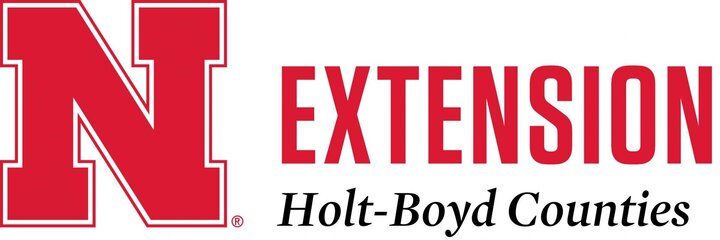
Nebraska Extension Educator - Holt/Boyd Counties - LaDonna Werth
Nebraska Extension Educator - Holt/Boyd Counties - Amy Timmerman
Nebraska Extension Educator - Brown/Rock/Keya Paha Counties - Brittany Spieker
Nebraska Extension Educator - Holt/Boyd/Garfield/Loup/Wheeler Counties - Bethany Johnston
Nebraska 4-H Assistant - Holt/Boyd Counties - Debra Walnofer
August 2-9: Holt County Fair, Holt County Fairgrounds, Chambers, NE
August 18: DUE: Non-Perishable State Fair 4-H Exhibits, at your County Extension Office, either Butte or O’Neill, NE
August 19: DUE: Perishable State Fair 4-H Exhibits, at your County Extension Office, Butte or O’Neill, NE
August 22 – September 1: Nebraska State Fair, Grand Island, NE
Pay Attention To Your Child’s Good Behavior
All children will misbehave at times. Parents often try to teach children by attending primarily to their misbehavior, but when children behave appropriately, parents may be missing the opportunity to acknowledge and encourage that behavior.
When parents focus on misbehavior, the information the child receives is generally negative, possibly including threats or criticism, which may lead the child to misbehave more. If you were criticized all the time and were not given credit for things you did right and good, how would you feel? Children have the same feelings and reaction.
If a parent ignores good behaviors, always criticizes the child and only pays attention to bad or annoying behaviors, the child begins to talk back or argue, and then the parent gets more angry. This pattern becomes a negative cycle. Bad behaviors will occur more often in the future as a result.
According to Dr. Alan Kazdin of Yale University Parenting Center and Child Conduct Clinic, “Attention to bad behavior increases bad behavior (yelling, lecturing, scolding, spanking and punishing are all forms of negative attention), while attention to good behavior increases good behavior.”
When you really like what your child is doing, tell him right away. Be specific to praise the action, words or behavior to let the child
LaDonna Werth
Extension Educator
Phone: 402-336-2760
E-mail: lwerth2@unl.edu

know what it was he did right. For instance, saying “I like how you clean your room” is more effective than saying “You are a good boy.” Use a smile and give your child a hug, a high five or a touch on the shoulder.
Here are some tips you can follow to guide your child toward good behavior:
- Every child needs attention. It is better to give them positive attention for good behavior than negative attention for misbehavior.
- Don’t save attention for perfect behavior. Pay attention to your child for good or appropriate behavior.
- The more immediate your positive attention to your child’s good behavior, the more likely your child will associate the good feelings with that specific behavior and with positive behavior in general.
- Show your enthusiasm and let your child see how thrilled you are with their good behavior.
Source: Nina Chen, Ph.D., CFLE, Human Development Specialist, University of Missouri Extension
What is Corn Sweat?
Corn Sweat is a Marketing Term
The term corn sweat is being used a lot right now to talk about the excessive humidity that we get at times in the summer in the central U.S. But corn sweat is really just the media's way of describing evapotranspiration (ET). In other words, it's a clever marketing term.
ET is not limited to row crops either; most of the plants we are familiar with have stomata and transpire water vapor when there is daylight and they have water in the soil to transpire. But our row crops, especially corn, can transpire significant amounts of water vapor into the lower part of the atmosphere during the summer months.
Can't Blame All Humidity on the Corn
Much of our humidity in the summer is a result of us tending to have predominant southerly flow in the summer, which brings up warm, moist air from the Gulf. We also have fully leafed-out trees and other plants that transpire, which add extra water vapor to the atmosphere. Warmer air can hold more water vapor (see ClausiusClapeyron rule). So, for a variety of meteorological and biological reasons, our dewpoints would still be modestly high in the summer in this region of the country even if we had never plowed up the prairies and planted corn.
Amy Timmerman
Extension Educator
Phone: 402-336-2760
E-mail: atimmerman2@unl.edu

Suitable Soils
Before we get into the corn's ET rates, let's take a look first at the reason corn can grow quite successfully in the Corn Belt.
As you go further west in the Plains, the grasses get shorter due to less precipitation and/or shorter growing seasons. But the areas with the richer soil are also ideal for row crops like corn. The confluence of rich soil and relatively consistent precipitation without too much excessive heat has made states like Iowa and most of Illinois ideal places for corn. So, part of the reason we get extra humidity is the combination of ecological and geological fate coming together to produce some of the richest soils in the world that are perfect for corn.
Corn Sweat Not Equitable
Graph comparing crop evapotranspiration (ET) and reference ET across the corn growing season from May to September. The red line shows reference ET peaking in mid-summer, while the blue line shows crop ET lagging slightly behind. Corn growth stages are illustrated below the graph, progressing from seedlings in May to fully mature and drying plants in September.
Earlier in the season when corn is in its early development stage, ET is much less than it is during the tasseling to milk stages. And as we start winding down the summer, the corn crop starts needing less water and thus is transpiring less. But during the middle of the summer when the corn is going through its reproductive stage, it needs and will use a lot of water. This also conveniently happens when we are climatologically at our peak for temperature, which thanks to Clasius-Clapeyron, means that the atmosphere can hold that extra water vapor and our surface dewpoints can be very high.
Thus, we tend to have our highest dewpoints in the back half of July and the first half of August when corn ET is at a peak. Soybean can have higher ET rates in August than earlier in the summer, so sometimes the soybean can help offset the drop in corn ET. Regardless, if you want to blame the corn for a humid day in May or September, you are probably blaming the wrong source. But during this time of year, the blame is earned. As of current writing, most of the western half of the Corn Belt has dewpoints in the 70s, almost pushing 80 in parts of Iowa, Missouri and Illinois.
Map of the United States showing dewpoint temperatures in degrees Fahrenheit at 4:00 p.m. CDT on July 22, 2025. Higher dewpoints (in green) are concentrated in the central and eastern U.S., while much lower dewpoints (in yellow to brown) appear across the western states, especially the Southwest. Data provided by NOAA and displayed by Mesonet.
Drought Makes a Difference
The higher ET rates are a sign that the crops are healthy and able to transpire water. When corn (like other plants) gets water stressed, its protective mechanism is to close its stomata (leaf roll) to preserve soil moisture. When soil moisture gets deficient, the stomata take a very long break during the day. They are the business that is open for an hour in the morning and an hour late in the day so plan accordingly. If this persists for days and weeks, photosynthesis is minimized, and the crop yields poorly or fails entirely.
In years where we see widespread drought in the Midwest, the dewpoints tend to be much lower because of the reduced ET. There were a lot of hot days, partly because it's easier to heat up dry air and dry soil. But the late season heat that year was more "comfortable" because the dewpoints were in the 50s and low 60s instead of 75 in places like eastern Nebraska and Iowa.
Source: Eric Hunt - Agricultural Meteorology and Climate Resilience Extension Educator (CropWatch – July 25, 2025)
Getting Reacquainted with the Cattle Comfort Index (CCI)
As temperatures rise, so does the risk of heat stress for feedlot cattle—affecting everything from health to performance and profitability. The Temperature Humidity Index (THI) provided producers with a guide to managing heat risk.
But now, the Cattle Comfort Index (CCI) is available for current conditions in a statewide map on the Nebraska Mesonet with sidebar access to each weather station (Figure 1) or as current and forecast conditions on the High Plains Regional Climate Center website (HPRCC; ) for each weather station.
These tools are available through a collaboration between Nebraska Mesonet and HPRCC. The CCI was developed by Dr. Terry Mader, University of Nebraska-Lincoln Animal Science Emeritus Professor, and collaborators while at the Haskell Agricultural Laboratory in Concord, Nebraska.
The Cattle Comfort Index (CCI) includes:
- Wind speed
- Solar radiation (sun exposure)
- Air temperature
- Humidity
Bethany Johnston
Extension Educator
Phone: 402-336-2760
E-mail: bjohnston3@unl.edu

Together, these factors offer a more accurate picture of what cattle experience - not just what the thermometer and hygrometer say.
Why move beyond THI?
While THI offers a basic snapshot of heat risk by combining temperature and humidity, it overlooks several critical environmental factors that affect cattle comfort and heat load.
These variables combine to better reflect the actual conditions cattle experience, including the effects of both heat and cold stress. For example, at the same temperature and humidity, a hot, breezy day with cloud cover poses lower risk than a hot, still, sunny day—CCI captures that difference, while THI does not.
How to start using CCI
The current CCI is available as a statewide map or for each station.
- Navigate to the Nebraska Mesonet website.
- Preview the CCI map.
- For additional station-specific information, select the station on the right-side ribbon.
The current and forecast CCI are already integrated into the HPRCC website:
- HPRcc website example
- Navigate to the HPRCC website: https://hprcc.unl.edu/stationtool/explore.php#
- Select the AWDN tab (Figure 4)
- Select Network: NeMesonet
- Select Station/Location
- Select Hourly Cattle Comfort Index
- Enter Date Range
Why CCI matters for your operation
Think of CCI as your early warning system specifically for livestock.
- Spot heat events sooner
- Make proactive decisions - adjust feeding, water access, or shade
- Reduce performance losses and death loss
- Provide animal comfort and enhance stress recovery
Understanding and using CCI
When Dr. Mader and collaborators developed the CCI, they used data from previous years on effects of weather events on cattle performance. Heat stress in animals results from the cumulative effects of the factors modeled by the index and the capacity of each animal to respond to these.
Using performance data and their observations, Dr. Mader and collaborators developed a set of CCI thresholds for heat stress. They emphasized that these thresholds are arbitrary and may be shifted based on age, adaptation to thermal stress, insulation and fat content, size, shape and feed intake.
Simulating an event at 86° F in which there is no solar radiation protection or cloud cover, and wind speed varies from 5 to 15 mph with relative humidity ranging from 30 to 70% results in a range of CCI from 90 to 106. A CCI of 89 reflects mild heat stress while a CCI of 104 is indicative of extreme heat stress. Incidentally, the July average maximum temperature in Northeast Nebraska is 86° F.
Cattle Comfort Index is simulated at 86° F in which there is no solar radiation protection or cloud cover, and wind speed varies from 5 to 15 mph in with relative humidity ranging from 30 to 70%. (Right panel): Cattle Comfort Index is simulated at 86° F and solar radiation is blocked by 70%, wind speed is set at 10 mph with relative humidity ranging from 30 to 70%.
Cattle Comfort Index is simulated at 86° F in which there is no solar radiation protection or cloud cover, and wind speed varies from 5 to 15 mph in with relative humidity ranging from 30 to 70%. Cattle Comfort Index is simulated at 86° F and solar radiation is blocked by 70%, wind speed is set at 10 mph with relative humidity ranging from 30 to 70%.
The results of this simulation demonstrate the negative effect of high humidity at the same temperature. From Table 1 and Figure 5 (left panel), keeping wind speed at 5 mph and temperature at 86° F, demonstrated an increase in CCI from 98 to 101 to 104 corresponding to relative humidity at 30%, 50% or 70%, respectively.
Similarly, from this simulation the effects of wind speed are noted. Simulated increases in wind speed reduced the value of CCI from 98 to 89, from 101 to 93, or from 104 to 96 for relative humidity set at 30%, 50% or 70%, respectively.
Lastly, this exercise demonstrates the positive effect of access to shade at 86° F with windspeed fixed at 10 mph and humidity ranging from 30% to 70%. Blocking 70% of solar radiation (common when using commercial shade structures) reduced CCI by 5 units.
CCI component tradeoffs
Summers in the high plains are warm and humid, with solar radiation constant; therefore, windspeed represents the single factor that might make a difference in hot and humid days. Given these conditions, and the fact that most folks rely on weather apps on their cellular devices to plan their day, understanding the relationships between CCI components may serve as an early prompt to review the CCI.
Two series of simulations (one at full solar radiation and one with 70% solar radiation block) to determine CCI under various conditions were undertaken. Simulations were generated with temperatures ranging from 76° F to 100° F in 2-degree increments while wind speed and relative humidity were permitted to vary from 5 to 15 mph or 30% to 85% in 5-unit increments.
Under full solar radiation the following equivalencies were determined. At the same relative humidity, CCI values were equivalent when a change in temperature of 1° F was offset by a change in windspeed of 2.5 mph. Similarly, holding temperature constant, a change in windspeed of 5 mph was required to offset a change in relative humidity of 15 percentage units. Lastly, holding windspeed constant, a change in relative humidity of five percentage units was required to offset a change in temperature of 1 degree.
When solar radiation was blocked by 70%, CCI values were reduced by 5 units. Therefore, equivalent values of CCI components are:
Temperature | Windspeed | Relative humidity |
1 | 2.5 mph | 5 percentage units |
These values are intended to serve as guidance to encourage visiting the Nebraska Mesonet or HPRCC websites, once temperature, windspeed or relative humidity forecast are reviewed when casually assessing weather conditions on most cellular devices.
A proposed approach would be to review the 10-day forecast daily.
- If temperatures are expected to reach past 80° F, then this is the prompt for the user to consider relative humidity and windspeed.
- If relative humidity is expected to exceed 65% or if windspeed is expected to be slower than 10 mph, or both, the user should proceed immediately to review the CCI.
An application of this example, using the current 10-day weather forecast, shows a day with a high of 90° F with relative humidity of 60% and windspeed at 7 mph. This should be the prompt to review the CCI forecast and to prepare for an expected CCI above 100 (extreme) and expected heat stress.
As temperatures rise, so does the risk of heat stress for feedlot cattle, which CCI can be an early warning system for livestock.
Source: Alfredo DiCostanzo - Nebraska Extension Educator, Ruth Woiwode - Nebraska Extension Specialist - Animal Care & Handling (BeefWatch – July 21, 2025)